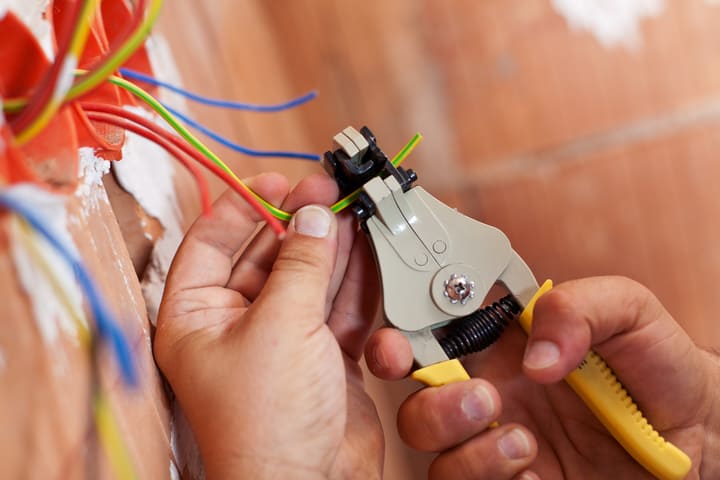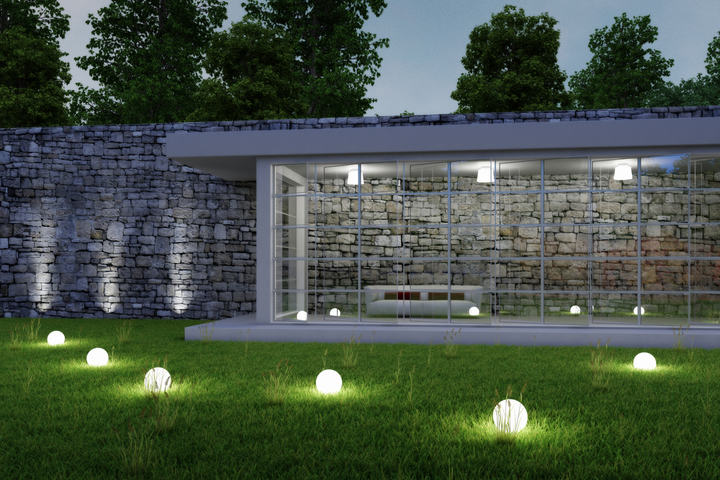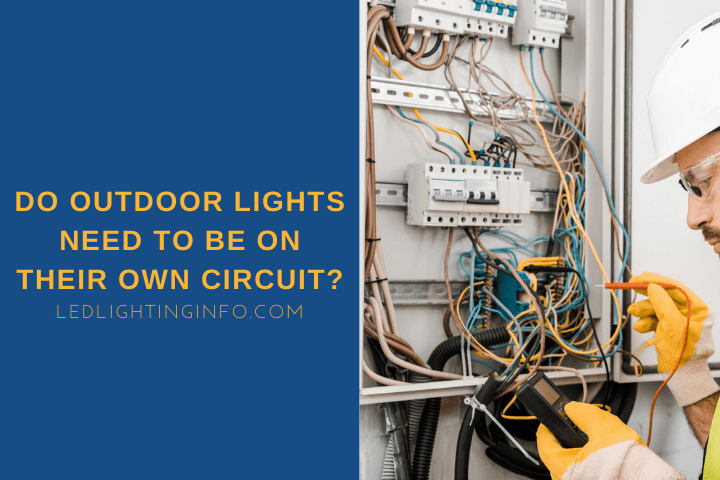Whether you’re planning to add new outdoor lighting to your home, or you’re carrying out some re-wiring work and want to make sure your existing outdoor lights are connected in the best way, it’s important to consider whether they need their own circuit.
A lot of the time, outdoor lights are an afterthought.
They are installed after all the main electrical work has been done – and so it’s not uncommon to see them wired into an existing circuit for indoor lighting. But is that OK?
Ideally, outdoor lights should be on a separate circuit – that way, if something goes wrong, they don’t trip the indoor lighting too. They don’t have to be on a separate circuit, but you have to properly insulate the circuit to protect it from the weather.
In this article I’ll explain:
- The type of circuit outdoor lights should be on
- The cable types you need for outdoor lights
- Whether you can wire outdoor lights to an indoor switch
What Circuit Should Outdoor Lights Be On?

There are two main types of circuits that you can use when wiring any form of lighting (or indeed anything electrical) – series or parallel.
If you choose a series circuit, then the circuit is one consistent loop, with every light wired ‘in series’ after the previous one. In a parallel circuit, each light is on its own loop.
With garden lighting, there are a few things to consider, but the most obvious one will be how complicated your circuit needs to be.
Suppose you’re only installing a couple of wall lights.
In that case, you or your electrician might have fewer problems wiring a parallel circuit. Still, for stake or string lights, you need to think about how you could wire in parallel without tearing up your whole garden or decking.
Parallel circuits are always better when possible because if there’s a fault on the circuit, it’ll only affect the part of the loop it’s on.
So if one bulb fails, the rest of the bulbs will still work, and you won’t have to be in the dark until you’ve repaired or replaced the issue.
In a series, when one bulb goes off, the rest stop working – which also means there’s more work to do identifying the problem.
But wiring in parallel outdoors isn’t easy. Indoors, you have the protection of your home and its natural defenses against weather and other interfering factors.
Outdoors, you need to make sure all wires are safe. That means complete waterproofing and also protection from plant roots and animals too.
A series circuit might make more sense if you’re adding outdoor lighting without significant renovations.
But if you’re adding outdoor lights that are part of a bigger garden overhaul, as is often the case, make sure to plan your lighting circuits ASAP so you can safely insulate and bury them as needed.
In terms of amperage, you’ll want your outdoor lights on a 5-amp circuit. 13 amps is way too much and won’t be sustainable on the wiring you’ll use, but 3 amps may limit your lighting options.
What Cable Is Suitable For Outdoor Lighting?

Your outdoor lighting circuit is exposed to a lot more dangers than your indoor lighting. Think about it:
- How often does it rain indoors?
- How many wild animals do you have roaming inside your walls, potentially nibbling your wiring?
- How many plants do you have growing and extending their roots through your indoor circuitry?
I’m hoping the answer to all the above is zero.
Plus, then you need to think about your own mishaps – while yes, it’s possible to hammer a nail into a wire indoors if you aren’t careful, that’s not common.
But how frequently might you be digging with a shovel or mowing the lawn near an outdoor cable?
So that’s a lot to consider. This is why you need to think carefully about protecting your wiring when installing outdoor lights.
You’ll therefore want to use SWA cabling. SWA stands for steel-wire-armored, which gives you a hint as to why you should use it.
It’s insulated with rubber rather than PVC. PVC-sheathed cable can be watertight, but it’ll be weakened by exposure to UV light from the sun and could crack.
The steel armoring will help protect it from animals that could bite through the rubber in weaker areas.
However, you’ll still need to bury the cable because even steel-armored cable can be cut through by lawn mowers or shovels.
1.5mm cabling is usually the right thickness to carry enough load for outdoor lights. It will be secure enough to use safely.
Aim to bury cabling at least 450mm (around 1.5 feet) in the ground when under paths or driveways, or 750mm (around 2.5 feet) deep if it’s somewhere that may be dug up.
You should late electrical route marker tape at around 150mm (0.5 feet) deep too, to serve as a warning.
Related: What Is The Best Season To Install Landscape Lighting?
Can You Wire An Outside Light To An Indoor Switch?

How to control your outdoor lights is something you’ll also need to consider.
Many people will install motion detectors or ambient light detectors, ensuring that the outdoor lighting comes on when needed.
But most of the time, you’re going to want some form of manual control, so a switch will be needed.
So you will be able to wire an outside light to an indoor switch, giving you control over the lights.
Having said that, there are some important considerations, again around the safe installation of your lighting circuit.
You won’t have any problems if you’ve wired the whole circuit for your outdoor lights as standalone and you’re only using an indoor switch.
Provided you’ve followed all the advice above for making sure it’s safe.
But suppose you’re wiring your outdoor lights on any indoor circuit and you don’t have the outdoor elements completely sealed.
In that case, you’re risking danger because bad weather could easily get moisture into your indoor circuit and cause a major hazard.
Also read: Can You Add Motion Sensor To Existing Outdoor Lights?
FAQ
Do Outdoor Lights Require GFCI?
A ground fault circuit interrupter or GFCI is required for any outdoor lighting under section 210.8 of the National Electric Code (NEC).
Because outdoor lighting circuits are more exposed to the elements or interfere with plants and animals, they must be protected.
A GFCI will monitor the electrical input and de-energize the circuit if an imbalance is detected due to a fault – preventing many hazards.
Can I Power Outside Lights From The Socket?
You can power outside lights from a socket.
Many are designed to be used this way already, although if you’re wiring your own plug into outdoor lights, make sure that the socket circuit can handle the load.
The socket circuit will also need a GFCI to ensure it is safe.
If you’re plugging a light into an existing socket circuit that has GFCI, then you should be fine.
Adding a socket to a dedicated lighting circuit is technically doable. Still, it isn’t preferable, and you would be better off choosing lights that can be wired on their own circuit.
Final Words
Outdoor lighting installation isn’t easy.
There are a lot of extra factors to consider when compared to indoor lighting, which means a lot more that could go wrong.
It’s always better to have outdoor lighting on its own circuit when you can since it means you’ll have a lighting circuit that cuts off if something does go wrong.
Just make sure all cabling is appropriately insulated and buried. And if you aren’t sure, hire a trusted electrician to do it for you.
Outdoor lighting that hasn’t been installed correctly is a potential hazard.
Have you installed outdoor lights in your home?
Did you do it as a standalone job or as part of a total garden overhaul, and what experiences did you have? Any problems since?

